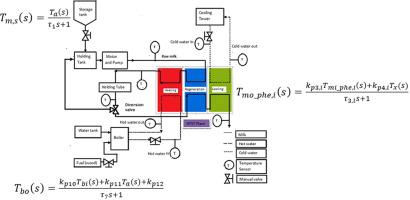Applied Thermal Engineering ( IF 6.1 ) Pub Date : 2021-02-06 , DOI: 10.1016/j.applthermaleng.2021.116674 M. Indumathy , S. Sobana , Rames C. Panda

|
This article discusses the steady-state and transient performances of continuous High-Temperature-Pasteurisation-Process (HTST) - milk plant. The plant comprises of integrated three-stage sections (regeneration, heating and cooling) counter-current gasketted-Plate-Heat-Exchanger (PHE) along with holding-tank, boiler, chiller unit and holding-tube. The conservation of mass and energy principle is applied in modelling the plant. Modelling of heat-exchanger is improved using Log-Mean-Temperature-Difference (LMTD) approach. Using this approach, where a rise of about 1 °C has been observed in the temperature of the heat-exchanger’s heating section, and the transient representation of heat-exchanger is thus improved. Fouling is a major issue in a dairy industry, as it incurs additional energy and cost. Moreover, problems due to fouling of exchangers lead to abnormal flow and temperature profile. This makes the pasteurisation difficult to control. Thus, fouling prediction is vital in grass-root design and even more, in retrofit applications. Therefore, the dynamic-behavior of the plant is also augmented by introducing one-dimensional predictive fouling-model (around a thickness of 2.8 x 10-5 m) in the overall integrated plant. It is observed that the reduction of 0.5 °C in pasteurised milk temperature approximately, reduces the quality of milk. The dynamic-model of HTST process is validated with experimental plant data. The sensitivity analysis of the model is also presented. The results of the integrated model are useful in constructing a good control strategy to improve the overall performance, reliability, efficiency, quality-control and economic benefits of the dairy farm.
中文翻译:

板式换热器高温巴氏灭菌过程中的结垢建模
本文讨论了连续高温巴氏杀菌工艺(HTST)-牛奶厂的稳态和瞬态性能。该工厂由集成的三阶段部分(再生,加热和冷却),逆流带垫片的板式换热器(PHE)以及储气罐,锅炉,冷却器单元和储气管组成。质量和能量守恒原理在工厂建模中得到应用。使用对数平均温度差(LMTD)方法改进了热交换器的建模。使用这种方法,可以观察到热交换器的加热部分的温度上升约1°C,从而改善了热交换器的瞬态表示。结垢是乳制品行业的主要问题,因为它会产生额外的能源和成本。而且,换热器结垢引起的问题会导致流量和温度分布异常。这使得巴氏灭菌难以控制。因此,结垢预测对于基层设计乃至改造应用至关重要。因此,通过引入一维预测结垢模型(厚度约为2.8 x 10),还可以增强工厂的动态行为。-5 m)在整个综合工厂中。可以看到,巴氏消毒牛奶的温度大约降低0.5°C,会降低牛奶的质量。HTST过程的动态模型已通过实验工厂数据进行了验证。还介绍了模型的敏感性分析。集成模型的结果可用于构建良好的控制策略,以提高奶牛场的总体性能,可靠性,效率,质量控制和经济效益。











































 京公网安备 11010802027423号
京公网安备 11010802027423号